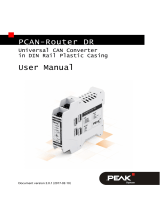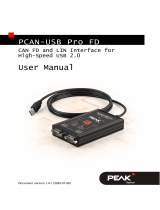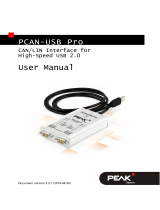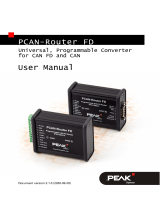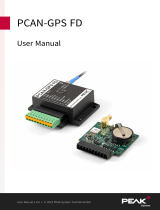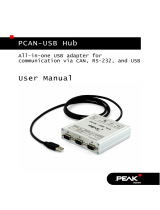Page is loading ...

Universal Programmable
CAN Converter
User Manual
PCAN-Router
Document version 1.4.0 (2013-10-31)

PCAN-Router – User Manual
2
Products taken into account
Product Name Model Part number
PCAN-Router 2 D-Sub connectors,
additional digital input
IPEH-002210
PCAN-Router Screw terminal block,
additional serial interface
IPEH-002210-P
PCAN-Router opto-
decoupled
2 D-Sub connectors,
galvanic isolation for connector CAN2,
additional digital input
IPEH-002211
CANopen® and CiA® are registered community trade marks of CAN in Automation
e.V.
All other product names mentioned in this document may be the trademarks or
registered trademarks of their respective companies. They are not explicitly marked
by “™” and “®”.
© 2013 PEAK-System Technik GmbH
PEAK-System Technik GmbH
Otto-Roehm-Strasse 69
64293 Darmstadt
Germany
Phone: +49 (0)6151 8173-20
Fax: +49 (0)6151 8173-29
www.peak-system.com
info@peak-system.com
Documen
t version 1.4.0 (2013-10-31)

PCAN-Router – User Manual
3
Contents
1 Introduction 5
1.1 Properties at a Glance 5
1.2 Scope of Supply 6
1.3 Prerequisites for Operation 6
2 Connectors and Coding Solder Jumpers 7
2.1 D-Sub Connectors 8
2.1.1 Supplying External Devices via the CAN
Connector (D-Sub only) 10
2.2 Screw Terminal Block 11
2.3 J4 Connector Panel: Serial Ports 12
2.4 J5 Connector Panel: JTAG Ports 13
2.5 Coding Solder Jumpers 14
3 Operation 16
4 Software 17
4.1 Installing the GNU ARM Toolchain 17
4.2 Library 18
4.3 Firmware Examples 18
4.3.1 Compiling a Firmware Example 19
5 Firmware Upload 20
5.1 Uploading Firmware via CAN 20
5.1.1 System Requirements 20
5.1.2 Preparing Hardware and Software 21
5.1.3 Uploading the Firmware 22
5.2 Uploading Firmware via the Serial Connections 25
6 Technical Specifications 27

PCAN-Router – User Manual
5
1 Introduction
The PCAN-Router is a module with two CAN channels, the data
traffic of which is processed by a freely programmable microcon-
troller. This means that incoming CAN messages can be individually
evaluated, converted, and filtered in order to then send the adjusted
CAN messages to the respective other network.
You can copy any firmware you have developed yourself to the
PCAN-Router via the bootloader, which has already been implemen-
ted, by using CAN. The PCAN-Router is supplied with an example
firmware which forwards CAN messages 1:1 between the two
channels at 500 kbit/s. The respective source code is included on the
supplied DVD.
1.1 Properties at a Glance
Microcontroller of the NXP LPC21 series (16/32-bit ARM CPU)
External 32-kByte EEPROM
Two High-speed CAN channels (ISO 11898-2) with 40 kbit/s to 1
Mbit/s (lower bit rates on request)
One additional LIN channel on request
Galvanic isolation of the D-Sub connector CAN 2 for the opto-
decoupled model
Status indication with two duo LEDs
Two 9-pin D-Sub connectors or one 10-pin screw terminal block
(Phoenix)
Aluminum profile casing, DIN rail mounting option on request
Supply voltage from 8 to 30 V

PCAN-Router – User Manual
6
Extended operating temperature range of -40 to +85 °C (-40 to
+185 °F)
Import of a new firmware via CAN
Additional digital input (only applies to models with D-Sub
connectors IPEH-002210/11)
Additional serial RS-232 interface (only applies to model with
screw terminal block IPEH-002210-P)
4-bit coding of the hardware by solder jumpers
1.2 Scope of Supply
PCAN-Router in aluminum profile casing
10-pin screw terminal block (IPEH-002210-P only)
Windows development software (Yagarto GNU ARM toolchain,
flash program)
DVD with library, programming examples, and manual in PDF
format
1.3 Prerequisites for Operation
Voltage supply within a range of 8 to 26 V DC (up to 30 V with
IPEH-002210(-P) from ser. no. 01000 and IPEH-002211 from
ser. no. 00020)
For uploading a new firmware via CAN:
• CAN interface of the PCAN series for the computer
(e.g. PCAN-USB)
• Operating system Windows 8/7/Vista/XP (32/64-bit)

PCAN-Router – User Manual
7
2 Connectors and Coding
Solder Jumpers
Depending on the model the PCAN-Router has the following
connectors:
two 9-pin D-Sub connectors (IPEH-002210/11)
one 10-pin screw terminal block (IPEH-002210-P)
For direct access to the serial and debugging ports of the micro-
controller, additional – yet not equipped – connector panels are
available on the board of the PCAN-Router.
Furthermore the PCB has four coding solder jumpers in order to
assign a fixed status to the corresponding input bits of the micro-
controller. A concrete application is to identify a PCAN-Router on
the CAN bus for a firmware upload, especially if there are several
routers connected and in operation.
The following subsections describe each connector assignment.

PCAN-Router – User Manual
8
2.1 D-Sub Connectors
(IPEH-002210 and IPEH-002211)
The two D-Sub connectors are used for the CAN channels CAN1 and
CAN2.
The voltage supply can be done via both connectors, with the opto-
decoupled model only via connector CAN1. The supply connections
+U
b1
and +U
b2
are connected internally in a reactionless configura-
tion. This means that different power sources can be connected if
applicable.
Connector CAN1 additionally offers an input to activate the
bootloader named Boot CAN1 (see also section 5.1
Uploading
Firmware via CAN
on page 20).
Connectors CAN2 or CAN1 (see assignment tables below) have an
additional digital input named Din0 which can be utilized by the
microcontroller.

PCAN-Router – User Manual
9
Pin distribution D-Sub connector
PCAN-Router IPEH-002210:
Pin Function connector CAN1 Function connector CAN2
1 +5 V for external devices (optional)
1
+5 V for external devices (optional)
1
2 CAN1_L CAN2_L
3 GND GND
4 Reserved (LIN) Not used
5 SHIELD SHIELD
6 Boot CAN1 (High-active) Not used
7 CAN1_H CAN2_H
8 Not used Din0 (Low-active)
9 Supply +U
b1
2
Supply +U
b2
2
PCAN-Router opto-decoupled IPEH-002211:
Pin Function connector CAN1 Function connector CAN2
1 +5 V for external devices (optional)
1
+5 V for external devices (optional,
via DC/DC converter)
1
2 CAN1_L CAN2_L
3 GND1 GND2
4 Reserved (LIN) Not used
5 SHIELD SHIELD
6 Boot CAN1 (High-active) Not used
7 CAN1_H CAN2_H
8 Din0 (Low-active) Not used
9 Supply +U
b1
3
Not used
1
See following subsection 2.1.1
2
8 - 26 V DC, up to 30 V from ser. no. 01000
3
8 - 26 V DC, up to 30 V from ser. no. 00020

PCAN-Router – User Manual
10
2.1.1 Supplying External Devices via the CAN
Connector (D-Sub only)
On the circuit board of the PCAN-Router a 5-Volt supply can
optionally be routed to each pin 1 of the D-Sub connectors CAN1
and CAN2. Thus devices with low power consumption (e.g. bus
converters) can be directly supplied via the CAN connector. The
current consumption may not exceed 100 mA per connector.
Proceed as follows to activate the 5-Volt supply:
In order to remove the circuit board unscrew the casing of the PCAN-
Router on both ends and pull the board from the casing profile.
Set the solder jumper(s) on the circuit board according to the
desired settings. During this procedure take especially care not to
produce unwanted short circuits on the board.
The following figures show the positions of the solder fields on the
bottom side of the PCAN-Router circuit board. The table below
contains the possible settings.
IPEH-002210 up to ser. no. 00458
IPEH-002210 from ser. no. 00459
and all IPEH-002211
5-Volt supply →
None Pin 1
CAN1 (R35)
CAN2 (R36)

PCAN-Router – User Manual
11
2.2 Screw Terminal Block
(IPEH-002210-P)
Apart from power supply and CAN channels, the screw terminal
block includes connections for a serial interface with RS-232 levels.
Terminal Function
1 Supply +U
b
4
2 GND
3 CAN1_L
4 CAN1_H
5 CAN2_L
6 CAN2_H
7 Boot CAN1 (High-active)
8 Reserved (LIN)
9 RS-232 RxD
10 RS-232 TxD
For further connection details that are not needed for programming
of the PCAN-Router because of implementation in a library, see also
Appendix C
Port Assignment of the Microcontroller
on page 31.
4
8 - 26 V DC, up to 30 V from ser. no. 01000

PCAN-Router – User Manual
12
2.3 J4 Connector Panel: Serial Ports
The unpopulated connector panel J4 on the board of the PCAN-
Router provides an access option to the serial ports of the LPC2129
or LPC2194/01 microcontroller (μC).
IPEH-002210(-P) up to ser. no. 00458
IPEH-002210(-P) from ser. no. 00459
and all IPEH-002211
Pin Signal Port μC
1 RxD0 P0.1
2 TxD0 P0.0
3 Not used
4 /Boot_ser P0.14
5 GND
6 +5.0 V
The RxD0 and TxD0 signals are forwarded to a level converter for
the RS-232 standard. The PCAN-Router model with screw terminal
block provides access to the adjusted signals at terminals 9 (RS-232
RxD) and 10 (RS-232 TxD).
Attention! The RxD0 (pin 1) and TxD0 (pin 2) signals in connec-
tor panel J4 are designed for TTL levels only. Using RS-232
levels at these connections can cause damage to the electronics
of the PCAN-Router.

PCAN-Router – User Manual
13
2.4 J5 Connector Panel: JTAG Ports
The unpopulated connector panel J5 on the circuit board of the
PCAN-Router provides an access option to the JTAG ports of the
LPC2129 or LPC2194/01 microcontroller (μC) for hardware debugging.
IPEH-002210(-P) up to ser. no. 00458
IPEH-002210(-P) from ser. no. 00459
and all IPEH-002211
Pin Signal Port μC Internal wiring
1, 2 GND
3 /Reset /Reset Pull-up
4 3.3 V
5 TCK P1.29 Pull-down (R30)
6 TMS P1.30 Pull-up
7 TDO P1.27 Pull-up
8 TDI P1.28 Pull-up
9 RTCK P1.26 Pull-down (R31)
10 TRST P1.31 Pull-up
If constant internal pull-down wiring of the TCK or RTCK signals is
not suitable for your purposes, you can remove the respective pull-
down resistor on the circuit board of the PCAN-Router by soldering
it out. Both resistors (each 10 kΩ) are located next to the J5
connector panel J5 (see figures).
IPEH-002210(-P)
up to ser. no. 00458
IPEH-002210(-P) from ser. no. 00459 and all IPEH-002211
Top side of the PCB | Bottom side of the PCB

PCAN-Router – User Manual
14
2.5 Coding Solder Jumpers
The four positions for coding solder jumpers (ID 0 - 3) are each
assigned to one port of the microcontroller LPC 2129 or LPC2194/01
(μC).
IPEH-002210(-P) up to ser. no. 00458
IPEH-002210(-P) from ser. no. 00459
and all IPEH-002211
Position 0 1 2 3
Port μC
P0.4 P0.5 P0.6 P0.7
Position is … Status at the port
bridged Low
open High
The status of the ports is relevant in the following cases:
The loaded firmware is programmed so that it reads the status
at the corresponding ports of the microcontroller. For example,
the activation of certain functions of the firmware or the coding
of an ID is conceivable here.

PCAN-Router – User Manual
15
For a firmware upload via CAN the PCAN-Router is identified by
a 4-bit ID which is determined by solder jumpers. A bit is set (1)
when the corresponding solder jumper position is open (default
setting: ID 15, all positions open).
Position
0 1 2 3
Binary digit
0001 0010 0100 1000
Decimal equivalent
1 2 4 8
See also section 5.1
Uploading Firmware via CAN
on page 20.

PCAN-Router – User Manual
16
3 Operation
The PCAN-Router is activated by applying the supply voltage to the
respective input pins (see chapter 2
Connectors and Coding Solder
Jumpers
on page 7). The firmware in the flash memory is
subsequently run.
The PCAN-Router is supplied with an example firmware which
forwards CAN messages 1:1 between the two channels at 500 kbit/s.
An incoming CAN message causes a change between green and
orange of the LED status indication for the respective CAN channel.
The source code for the example firmware 1_ROUTING and further
examples is included on the supplied DVD in the following directory
branch:
/Develop/Microcontroller hardware/PCAN-Router/Example/

PCAN-Router – User Manual
17
4 Software
This chapter covers the installation of the Yagarto GNU ARM tool-
chain and gives notes about the software library and the firmware
examples.
Software, source code, and additional information are included on
the supplied DVD in the following directory branch:
/Develop/Microcontroller hardware/PCAN-Router/
4.1 Installing the GNU ARM Toolchain
To compile the code examples and the custom firmware code under
Windows, install Yagarto on your computer. Yagarto is a collection
of tools to develop applications for ARM processors and microcon-
trollers on Windows platforms. The collection includes the GNU
GCC compiler for C and C++, Make, and further tools. Further
information about Yagarto: www.yagarto.de
System r
equirement: Windows 8/7/Vista/XP (32/64-bit)
Do the following to install Yagarto:
1. From the directory branch on the provided DVD mentioned
above, change to the Compiler subdirectory.
The directory contains the two installation programs
yagarto-*.exe and yagarto-tools-*.exe.
2. Execute the first installation program and follow its
instructions.
If you don't want to use the default destination folder, make
sure that your customized path doesn't contain any spaces.
Otherwise compile operations will not work later.

PCAN-Router – User Manual
18
3. Afterwards, execute the second installation program and
follow its instructions.
In the system environment, the installation programs create search
paths for the executable files. These new search paths are effective
only for programs and command prompts that are started
afterwards.
4.2 Library
The development of applications for the PCAN-Router is supported
by the library libPCAN-RouterGNU*ys.a (* stands for version
number), a binary file. You can access all resources of the PCAN-
Router by means of this library. The library is documented in the
header files (*.h). The files are located in each example directory.
From version 2 of the library, all models of the PCAN-Router are
supported. Software code that is based on a previous version of the
library can be used with version 2 without any changes.
4.3 Firmware Examples
On the DVD, the Example subdirectory contains source code for
several firmware examples that you can use and test directly and
that you can reuse for custom firmware.
On delivery the PCAN-Router is supplied with the example firmware
1_ROUTING. It forwards CAN messages 1:1 between the two CAN
channels at 500 kbit/s. An incoming CAN message causes a change
between green and orange of the LED status indication for the
respective CAN channel.

PCAN-Router – User Manual
19
4.3.1 Compiling a Firmware Example
Do the following to compile a firmware example under
Windows:
1. From the provided DVD, copy the subdirectory of the
desired example from the Example directory to the local
hard disk.
2. Open a command prompt by using the Windows Start
menu. Alternatively you can press the key combination
á + R and enter cmd.exe as program to be executed.
3. At the command prompt change to the previously copied
directory.
4. Execute the following command in order to clean-up the
target directories (e.g. .out) from files that have been
generated earlier:
make clean
5. Execute the following command to compile the firmware
example:
make all
If the compiler has finished without errors (“Errors: none”),
you can find the firmware file with the extension .bin in the
subdirectory .out. This file is then used for firmware upload
to the PCAN-Router.

PCAN-Router – User Manual
20
5 Firmware Upload
The microcontroller in the PCAN-Router can be equipped with new
firmware in two different ways:
Via CAN. The scope of supply includes the Windows program
PCAN-Flash to transfer the firmware from the computer to the
PCAN-Router. This is the recommended method for a firmware
upload.
Via the RS-232 interface or the serial connections of the
microcontroller. For the latter access to the board of the PCAN-
Router is needed.
5.1 Uploading Firmware via CAN
5.1.1 System Requirements
The following prerequisites must be given, so that the PCAN-Router
can be updated with new firmware:
CAN interface of the PCAN series for the computer (e.g. PCAN-
USB)
CAN cabling between the CAN interface and the PCAN-Router
with proper termination (120 Ω on each end of the CAN bus)
Operating system Windows 8/7/Vista/XP (32/64-bit)
If you want to update several PCAN-Router connected to the
same CAN bus, you must assign a unique ID to each router. See
section 2.5
Coding Solder Jumpers
Seite 14.
/

